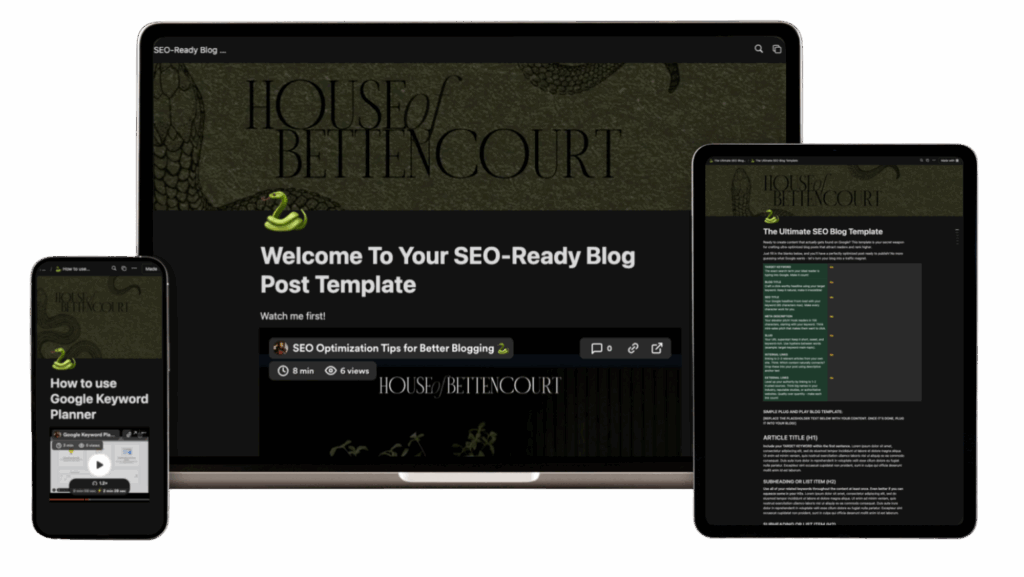Web strategist who helps creatives and service providers build websites designed to grow with them. Unlike other designers, I don’t just build for launch—I create strategic, scalable sites that stay valuable long after day one.
OH HEY!! I'M CHANTEL
Let’s tackle the question that’s probably keeping you up at night. How often should I blog for SEO?
If you’ve been down the rabbit hole of SEO advice, you’ve seen it all. Some experts say daily posts are essential. Others claim once a month is plenty. The truth? Most of that advice is either outdated or completely wrong.

The Myth of the Magic Blogging Frequency
Here’s what I wish someone had told me early on. There’s no magic number for how often you should blog for SEO. Seriously.
Google doesn’t have a little checkbox that says “blogs daily = automatic ranking boost.” If only it were that simple, right?
The obsession with blogging frequency comes from the early days of SEO. Back then, quantity actually did matter more than quality. You could publish thin, keyword-stuffed posts daily and see results. Those days are long gone.
Today’s SEO game is completely different. Google’s algorithm has evolved. It’s smarter, more sophisticated, and focused on user experience above all else.
What Google Actually Cares About
Before we dive into how often you should blog for SEO, let’s talk about what matters to Google’s algorithm.
Content Quality Over Everything
Google wants to serve users the best possible content for their search queries. This means comprehensive, well-researched, helpful content that actually answers questions.
A single amazing blog post that thoroughly covers a topic will outrank ten mediocre posts every single time. This isn’t just theory. I’ve seen it happen countless times with my own content and my clients’ sites.
User Experience Signals
Google pays attention to how users interact with your content. How long are they staying on your page? Are they clicking through to other pages on your site? Are they bouncing immediately?
These signals matter way more than how often you publish. A single post that keeps users engaged for five minutes is worth more than five posts that people leave immediately.
Content Freshness (But Not How You Think)
Yes, Google likes fresh content. But “fresh” doesn’t mean “new.” It means updated, accurate, and relevant.
A well-maintained blog post from last year can outrank a brand-new post. This happens when the older post is more comprehensive and useful.
Expertise, Authority, and Trust
Google evaluates content based on what they call E-A-T. Expertise, Authority, and Trust. This means they want content from people who actually know what they’re talking about.
You build this through consistent, valuable content over time. Not through daily posting of random topics.
The Real Answer: How Often Should I Blog for SEO?
After working with hundreds of clients and analyzing what actually moves the needle, here’s my honest answer.
For Most Small Businesses: 1-2 High-Quality Posts Per Month
This frequency works best for most businesses. Here’s why:
You can create comprehensive, well-researched content. When you’re not rushing to publish daily, you have time to dive deep into topics. You can research thoroughly, add examples, and create truly helpful content.
You can properly optimize each post for SEO. Optimization takes time. You need to research keywords, write compelling titles, create meta descriptions, and add proper internal links.
You can promote your content effectively. Writing the post is only half the battle. You need time to promote it on social media, in your email newsletter, and through other channels.
You can maintain consistency without burning out. Blogging is a marathon, not a sprint. It’s better to publish consistently for years than to burn out after three months.
For Content-Heavy Businesses: 1-2 Posts Per Week
Some businesses rely heavily on content marketing. Think coaches, consultants, and agencies. These businesses might benefit from more frequent posting.
But only if you can maintain quality. The moment quality drops, frequency becomes worthless.
For Local Businesses: 2-4 Posts Per Month
Local businesses can benefit from regular content. It establishes expertise and captures local search queries.
Focus on topics your local customers actually care about. Don’t write about industry trends if your customers don’t care about them.

Quality vs. Quantity: Why One Amazing Post Beats Ten Mediocre Ones
When people ask how often should I blog for SEO, they’re usually thinking about quantity. But here’s what actually happens when you prioritize quality over frequency.
Better Search Rankings
One comprehensive, well-optimized blog post can rank for multiple keywords. It can drive traffic for years.
I have blog posts from 2019 that still bring in leads every month. They rank well because they thoroughly cover their topics.
More Backlinks
Other websites are more likely to link to comprehensive, valuable content. A single amazing post can earn dozens of backlinks. Thin content rarely gets any.
Backlinks are still one of the strongest ranking factors. Quality content naturally attracts them.
Higher Engagement
Users spend more time on quality content. This sends positive signals to Google. They’re also more likely to share quality content.
This extends your reach beyond just search traffic. Social shares, email forwards, and word-of-mouth all stem from quality content.
Better Conversion Rates
Comprehensive content that actually helps your audience builds trust. It positions you as an expert. This leads to higher conversion rates from blog traffic.
Think about it. Would you rather have 1,000 visitors who spend 30 seconds on your site? Or 100 visitors who spend 10 minutes reading and then contact you?
The Content Depth That Actually Matters
Instead of worrying about how often should I blog for SEO, focus on creating content that’s truly valuable.
Comprehensive Coverage
Cover your topics thoroughly. If someone searches for information about your topic, your post should be their last stop.
This means covering all the important subtopics. Answer common questions. Provide actionable advice. Include examples and case studies when possible.
Original and Helpful Insights
Don’t just rehash what everyone else is saying. Bring your unique perspective. Share your experiences. Provide insights that your audience can’t find elsewhere.
This is how you stand out in a crowded online space. Anyone can repeat generic advice. Not everyone can share unique insights from real experience.
Proper SEO Optimization
Each post should target one primary keyword and related terms. Include your target keyword in your title, headers, and naturally throughout the content.
But don’t stuff keywords. Write for humans first. Google is smart enough to understand context and related terms.
Well-Structured and Scannable
Use headers, bullet points, and short paragraphs. Most people don’t read every word. They scan for the information they need.
Make it easy for them to find what they’re looking for. This improves user experience and keeps people on your page longer.

The Consistency Factor (This Actually Matters)
While frequency isn’t everything, consistency does matter for how often you should blog for SEO.
Builds Audience Expectations
When you publish consistently, your audience knows when to expect new content. This can lead to direct traffic and engagement signals that Google loves.
Regular readers are more likely to share your content. They’re more likely to link to it. They’re more likely to become customers.
Maintains Website Activity
Regular content updates signal to Google that your website is active and maintained. This doesn’t mean daily posts. But it does mean consistent activity over time.
An active website is more likely to rank well than one that hasn’t been updated in months.
Creates More Ranking Opportunities
More content means more opportunities to rank for different keywords. But remember, this only works if each piece of content is valuable.
Don’t create content just to have more pages. Create content that serves your audience and targets keywords they actually search for.
When More Frequent Blogging Makes Sense
There are some situations where increasing your blogging frequency for SEO makes sense.
You’re in a Competitive Niche
If you’re competing against websites that publish high-quality content frequently, you might need to match their pace. This is especially true in industries like marketing, finance, and health.
But don’t sacrifice quality for quantity. It’s better to publish less frequently with higher quality than to match their frequency with lower quality.
You Have a Content Team
If you have the resources to maintain quality while publishing more frequently, it can give you an advantage. This might include writers, editors, and SEO specialists.
Solo entrepreneurs rarely have these resources. Don’t try to compete with teams if you’re working alone.
You’re Targeting Time-Sensitive Topics
News sites and blogs covering trending topics benefit from more frequent publishing. Their content has a shorter shelf life.
Most business blogs don’t fall into this category. Your content should have longer-term value.
You’re Building Topical Authority
If you’re trying to establish yourself as the go-to resource in your niche, comprehensive coverage helps. This might require more frequent posting.
But focus on covering topics thoroughly rather than just posting more often.
Common Blogging Frequency Mistakes That Hurt SEO
Publishing Just to Publish
The biggest mistake I see is publishing content just to meet a schedule. Thin, unhelpful content actually hurts your SEO more than not publishing at all.
Google can identify low-quality content. It won’t rank well. Worse, it can hurt the rankings of your other content.
Ignoring Existing Content
Many bloggers focus only on creating new content. They ignore their existing posts. Updating and improving old content often provides better ROI than creating new posts.
Your old content is already indexed. It might already have some authority. Building on that foundation is often easier than starting from scratch.
Not Promoting Content
Publishing isn’t enough. If you’re not promoting your content through social media, email, and other channels, you’re limiting its potential impact.
Great content that nobody sees won’t help your SEO. You need to actively promote every piece you publish.
Focusing on Vanity Metrics
More posts doesn’t automatically mean more traffic or leads. Focus on metrics that matter. Organic traffic, time on page, and conversion rates are what count.
Don’t get caught up in publishing X number of posts per month if those posts aren’t driving results.
A Practical Framework for Your Blogging Schedule
Instead of obsessing over how often should I blog for SEO, use this framework.
Start with Your Capacity
Be honest about how much time you can realistically dedicate to creating quality content. Include time for research, writing, editing, optimization, and promotion.
It’s better to publish one amazing post per month than four mediocre ones. Quality always wins in the long run.
Focus on Your Audience’s Needs
What questions are your customers asking? What problems are they trying to solve? Create content that genuinely helps them.
Use tools like Answer the Public to find questions people are asking about your topics. Look at the “People also ask” section in Google search results.
Plan for Promotion
For every hour you spend writing, plan to spend at least that much time promoting your content. This includes social media, email newsletters, and outreach.
Most content creators spend 90% of their time writing and 10% promoting. This should be closer to 50/50.
Track What Matters
Monitor your organic traffic, keyword rankings, and conversion rates. Adjust your strategy based on what’s actually working.
Don’t just look at vanity metrics like page views. Focus on metrics that impact your business goals.
The Long-Term Perspective on Blogging for SEO
When thinking about how often should I blog for SEO, remember that SEO is a long-term game. Here’s what matters more than frequency.
Building Topical Authority
Consistently creating valuable content about your expertise area helps establish you as an authority. Google recognizes sites that comprehensively cover topics.
This doesn’t happen overnight. It takes months or years of consistent, quality content creation.
Creating a Content Foundation
Each quality blog post becomes a foundation you can build on. You can reference old posts in new ones. This creates a web of internal links that helps SEO.
Your content library becomes a valuable business asset over time.
Compound Growth
Quality content compounds over time. A post that ranks well can continue driving traffic and leads for years.
This is why quality matters more than quantity. A few great posts that rank well are more valuable than dozens of posts that don’t.
Long-Term Relationship Building
Consistent, valuable content builds relationships with your audience. These relationships turn into customers, referrals, and brand advocates.
This is the real value of content marketing. It’s not just about search rankings.
Tools to Help You Maintain Quality While Staying Consistent
Content Planning Tools
Editorial calendars help you plan topics in advance. This prevents the last-minute scramble to come up with content ideas.
Keyword research tools help you identify valuable topics. Focus on keywords your audience actually searches for.
Analytics tools help you track performance. Use this data to inform your content strategy.
Writing and Optimization Tools
Grammarly helps with editing and proofreading. Clear, error-free writing improves user experience.
SEO plugins help with optimization. They remind you to include target keywords and write meta descriptions.
Image optimization tools help with faster loading. Page speed is a ranking factor.
Promotion Tools
Social media schedulers help you promote content consistently. Don’t just post once and forget about it.
Email marketing platforms help you share content with your audience. Your email list is often your most engaged audience.
Analytics tools help you track promotion effectiveness. Focus your efforts on channels that work.
Advanced Strategies for SEO-Focused Blogging
Content Clusters and Topic Authority
Instead of random blog posts, create content clusters around main topics. This helps Google understand your expertise areas.
Start with a comprehensive pillar page about a broad topic. Then create supporting content that links back to it.
Updating and Refreshing Old Content
Google loves fresh, updated content. Regularly review your old posts and update them with new information.
This is often easier than creating new content from scratch. Plus, updated content often ranks better than new content.
Internal Linking Strategy
Link between your blog posts strategically. This helps search engines understand your site structure. It also keeps users on your site longer.
Don’t just link randomly. Link when it genuinely helps the reader.
Optimizing for Featured Snippets
Structure your content to appear in featured snippets. Use clear headers, numbered lists, and direct answers to common questions.
Featured snippets can dramatically increase your click-through rates.
Measuring Success Beyond Rankings
Track Business Metrics
Don’t just track search rankings. Track how your blog contributes to business goals. This might include leads, sales, or email signups.
Your blog should support your business objectives, not just drive traffic.
Monitor User Engagement
Look at metrics like time on page, bounce rate, and pages per session. These indicate whether your content is actually valuable to users.
High engagement signals to Google that your content is useful.
Assess Content Performance Over Time
Some content takes months to gain traction. Don’t judge success based on immediate results.
Track performance over 6-12 month periods to get a true picture of content success.
Ready to Stop Stressing About Your Blog?
Tired of trying to figure out the perfect blogging schedule while juggling everything else in your business? I get it. That’s exactly why I offer done-for-you monthly blogging retainer services. I handle the research, writing, optimization, and publishing so you can focus on what you do best – running your business.
LEARN ABOUT MONTHLY BLOGGING SERVICES
Not quite ready for done-for-you blogging? No worries! Start with my free SEO-Ready Blog Post Template. It’ll walk you through creating optimized blog posts that actually rank and convert.
DOWNLOAD FREE SEO BLOG TEMPLATE

Looking for more tips? Join my weekly newsletter, The House Blend—the only wake-up call you’ll actually look forward to. Packed with web wisdom, SEO tips, and creative ideas.
Join my email list “The House Blend
Ways you can work with me:

How Often Should I Blog for SEO? The Real Answer (Not What You Think)
Web strategist who helps creatives and service providers build websites designed to grow with them. Unlike other designers, I don’t just build for launch—I create strategic, scalable sites that stay valuable long after day one.
OH HEY!! I'M CHANTEL